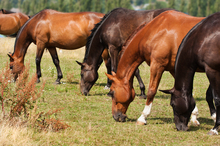Depending on where you live, autumn months bring a variety of weather conditions that affect horse owners, riders, and horses in ways that bring pleasure, but also in ways that are distracting, frustrating and create extra work for both the horse and the owner.

A season of change for horses and owners
Depending on where you live, autumn months bring a variety of weather conditions that affect horse owners, riders, and horses in ways that bring pleasure, but also in ways that are distracting, frustrating and create extra work for both the horse and owner.
According to Helene McKernan, Clinton County Extension, Pennsylvania State University, excessive rainfall can both benefit and hinder horse owners in managing farm systems and animal well-being. Unfortunately, for the horse owner, persistent and large amounts of rainfall often present challenges that are a nuisance and and can create health concerns for equines.
Warm wet climates assist forages with a rapid growth. This is a positive if your pasture in late summer had slowed down in growth. Pastures thrive on the late summer and early fall growing season.
Warm days followed by cool nights with moisture assist many grasses in rapidly regaining growth spurts that were stunted by the heat of summer. Grasses that usually are not as appetizing to the horse after a long hot summer, rejuvenate producing sweeter tasting forage that horses enjoy.
Often a horse will forage in areas in the pasture during the autumn months that were ignored during the summer. Clipping the forages to the desirable height will assist in maintaining the pasture for longer usage later in the growing season and will also assist in eliminating weeds.
Many weeds go to seed during the latter part of the summer and early fall and continual clipping will assist in reducing the spread of weed growth. The key is to clip the undesirable forages before there is the opportunity for seed heads to disperse.
With cooler autumn nights the nuisance of insects reduces assisting in more enjoyable riding time,but ponding in moist, muddy areas can become the breeding grounds for bacteria, flies and other types of insects.
Mosquitosâ larva thrives in stagnant waters found in drinking troughs and puddles. Draining and managing surface water areas can eliminate ponding. Adding a small amount of bleach to drinking troughs can assist in reducing mosquito and other insect breeding habitats.
With rainfall, areas in pastures, such as gate entrances, rapidly become soggy and muddy. This becomes a burden to both the horse owner and equine.
Horses standing and walking in muddy areas can promote hoof diseases, such as thrush and seedy toe. When standing in muddy areas horses can develop âgreasy heels.â
These conditions are similar to what happens in rain rot on the body of the horse, but are concentrated in the lower leg areas of the horse. If a horse develops these conditions, treatment and curing can be difficult as it becomes more difficult to eliminate contact with wet mud or grasses.
Removing mud on the lower legs and allowing the leg areas to dry daily will minimize issues. Severe cases can cause lameness and loss of the use of the horse for performance activities.
Many horses enjoy rolling in mud, which can prove to be a problem for owners who like to keep horses well groomed. The horse may use rolling in mud to cover its body to discourage biting insects, but more often the roll is intended to assist the horse in scratching âitchyâ areas.
Rain rot, common skin irritation in wet weather can produce hair loss and skin infection. Not only does this condition cause unsightliness, with the loss of hair, but also can become a threat to the health of the horse. Keeping the horsesâ coat clean and dry will deter rain rot.
Autumn horseback riding can be enjoyable and relaxing as the season becomes colder, the leaves more vivid in color, and the landscape begins to take on the tones of winter.
Careful maintenance of your horse during this period will ensure that you can enjoy the beauty of the season and enter the winter season in good health with a feeling of well-being.
